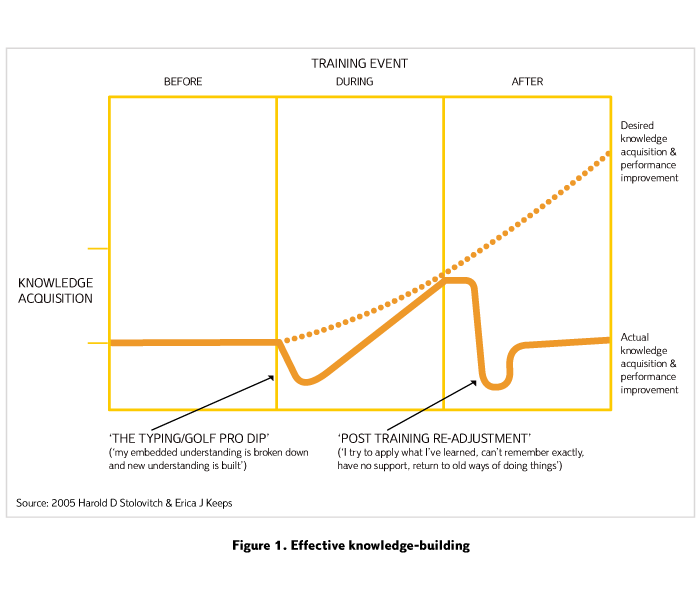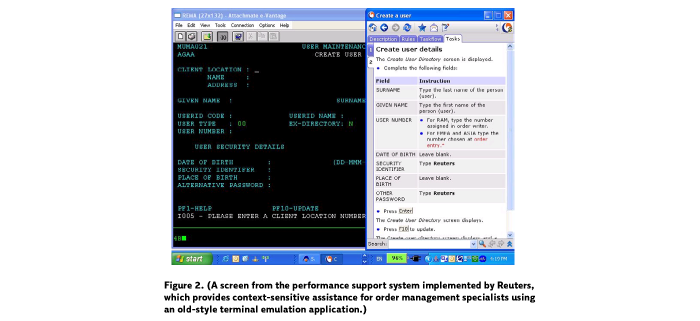“One of the most remarkable aspects of an animal’s behavior is the ability to modify that behavior by learning, an ability that reaches its highest form in human beings.”
Eric Kandel, neurophysiologist and Nobel laureate
Columbia University, New York
Building employee capability in a fast-moving world
Reuters is the world’s largest multimedia information company, publishing more than 8 million words in 18 languages every day and maintaining more than 200 million data records used by the world’s financial industry. This financial data is updated 8,000 times a second, increasing to 23,000 times a second at peak times. The volume and change rate of this data is such that the half-life of the information used by financial professionals to do their jobs is measured in milliseconds. So Reuters is one company that knows better than most how rapidly the nature of information and how we use it is changing.
Information, and the knowledge, skills, capability and innovation that are derived from it, powers the world’s economic engines and forms the fundamental particles of every business, every government agency and every economic entity, whatever their nature. What’s more, information is not in short supply. We live our lives in a world awash with it. In fact, the problem that the twenty-first century worker faces every day is not one of a lack of information, but one of having the right information at the right time.
Furthermore, most information, which is so fundamental to economic activity, is increasingly unstructured and short-lived. Information that was correct a month ago (or, indeed, a week, hour or minute ago) is increasingly likely to be incorrect at the point in time it is needed. The laws of physics will not change, but the number and type of materials available to an engineer for building a bridge or a house will be constantly changing, and the rate of change is increasing. It is the same for almost any industry, none more so than the ‘knowledge industries’ that have grown so rapidly over the past 50 years.
Information and learning
The increasing volume and decreasing half-life of most information calls into question the training model that educators have used for more than two thousand years – that of helping people turn information into knowledge, knowledge into skills, and skills into capability – because, if both the raw material and the intended environment are constantly changing, the end product built on that out-of-date information is likely to be unfit for purpose.
Just as the requirement for training blacksmiths disappeared almost overnight following Henry Ford’s development of production-line automobile assembly, the need for training people in formal learning environments for seemingly every other task is likewise disappearing with the rise of the information age. That is not to say that training is defunct; it certainly isn’t. However, we now need to look very carefully at how we train people and what we use training for, adopting different approaches where appropriate. The requirement for building employee capability hasn’t gone away; we just need to look at different ways to solve the problem.
Using workplace-based approaches to support capability building
Not only does information drive the world’s economic engines, it is also the raw material that every learning and training professional worldwide uses to help their workforce build its ability to turn information into decisions.
Since Plato’s founding of the Academy, tutors and trainers have spent a lot of their time using the course paradigm to transfer knowledge to students and employees in formal, structured learning environments. This approach has increasingly been shown to be both inefficient and ineffective. In a dynamic world where knowledge is exploding and its half-life is shortening, the key requirement is access to knowledge sources at the specific time the particular information is needed.
Effective learning
No more clearly is the lack of effectiveness of external (that is, away from the workplace) course-based training demonstrated than in the research carried out by Harold Stolovitch and Erica Keeps. Stolovitch and Keeps investigated the effectiveness of transfer and the retention of knowledge using such formal learning techniques. The results of their study are summarised in Figure 1.

The work of Stolovitch and Keeps proves something many of us know already: that if learning is carried out away from the work place and if there is no opportunity to put the newly learned knowledge and skills into practice almost immediately in the working environment, then the impact of the learning is lost almost entirely. This is especially the case if no support is provided when the employee returns to the workplace; they simply go back to doing what they were doing previously and performance improvement is zero.
This disappointing result can be explained in Eric Kandel’s terms as the inability of the learner to embed new behaviour into their long-term memory. Kandel’s work underpins the fact that acquiring new knowledge and using that knowledge to build new skills and modify behaviour (allowing an individual to achieve the ultimate goal of improving their performance) is only effective if the individual has an opportunity to practise, practise, and practise some more. Moreover, that practice needs to take place as near to the time they have learned it as possible. Kandel also suggests that if the acquisition of new knowledge can be integrated into the workplace, the process will be more effective still.
Efficient learning
Added to the effectiveness problem, for many learning professionals there is an increasing pressure to deliver efficient learning solutions. Value for money is the prime aim of many senior learning managers and their colleagues in the finance department. Traditional formal learning techniques such as training courses rarely represent good value for money, so where does that leave learning professionals and what are the alternatives?
Reuters 70:20:10 approach
Along with a number of other large corporations (including amongst others Goldman Sachs, Microsoft, Dell and Nokia) Reuters has adopted a 70:20:10 approach to building employee capability.
The 70:20:10 approach is based on research, summarised by Jay Cross in his excellent book Informal Learning: Rediscovering the Natural Pathways that Inspire Innovation and Performance, that has shown the majority of learning (approximately 70 per cent) occurs in the workplace, through doing the job. A further 20 per cent of learning happens through on-the-job coaching, networking (knowing the right questions to ask the right person), and obtaining feedback from colleagues, managers and team members. The research shows that only 10 per cent of learning that transfers into improved performance occurs through participation in formal learning events. Even if a person retains information and gathers knowledge in a formal learning environment, it is unlikely to equate to improved performance without on-the-job practice. In fact, a 1996 study carried out by Dana Robinson found that, on average, less than 30 per cent of what people learn in formal training actually gets used back in the workplace.
Repeated practice and support in the real working environment, therefore, appears to be the most effective way for people to acquire new knowledge and skills and to transform those skills into improved performance through embedding new practices into long-term memory.
Improving performance – embedding support and practice
As learning professionals we need to look to ways to overcome the inefficiencies inherent in formal learning if we are to produce effective and efficient performance outcomes within our workforce. This means embedding and supporting learning in the workplace, and bringing it as close to the task to be performed as possible.
However, we don’t have to invent totally new approaches. Along with some innovative solutions emerging with the second generation Web (Web 2.0) we can call on several tried-and-tested workplace learning solutions that have been in use for some time. A good starting point is Gloria Gery’s ground-breaking work, described in her 1991 book Electronic Performance Support Systems, on the use of these systems (often now simply called ‘performance support’, ‘embedded learning’ or ‘online job aids’). When such performance support is combined with other technology-based learning solutions, such as Web based e-learning content and online collaboration tools, a powerful suite of tools becomes available to learning managers.
Performance support at Reuters
For an example of this in practice we need look no further than Reuters. Along with adopting a learning approach (70:20:10) that aligns with research and increases the focus on workplace learning, Reuters has rolled out a performance support system (a screenshot of this is shown in Figure 2) for the teams of employees who manage customer orders, with considerable success.
The order management jobs are complex and, previously, an order management specialist (OMS) had to undergo extensive formal induction training before they could become productive on their desk. It was some ten weeks before the new specialist could start to take orders and, when they transferred to the desk to begin work, more experienced OMSs were devoting a large amount of time to supporting them. To address the time-to-desk issue and to reduce the demand on the experiences OMSs, Reuters deployed a next-generation performance support tool named SupportPoint within order management teams in St Louis, Sydney and Geneva customer support centres, providing the specialists with embedded, context-sensitive, on-the-job support.
The content delivered by performance support systems such as SupportPoint is focused absolutely on the task or action that needs to be completed at that point of time. The key aspect of performance support systems is their ability to provide the right help at the right point in the process. The result of this context sensitivity – whether it is delivered on-screen as a nugget of information, as a short eLearning piece, or as a diagram of the task that needs to be completed – is that it increases the employee’s ability to complete a task quickly and correctly. These systems provide the support that Stolovitch and Keeps identified as essential for improving performance.
Furthermore, repeated use of the performance support tool embeds real learning (in Eric Kandel’s terms) in the specialist’s long-term memory and leads to behaviour modification – something that is not generally achieved through formal learning. Even if assessments and certification are carried out immediately after formal training, they provide us with little more than an indication of what has been retained in short-term memory, rather than how behaviour has changed and performance improved.

Getting it right
If training departments are to earn their place as enablers of their organisations’ performance and productivity, it is imperative that they move their focus from the provision of formal learning, such as programmes and courses, to informal learning and, especially, performance support.
The mounting evidence that this approach to learning provides a greater impact on workplace performance means that, to meet the needs of twenty-first century organisations, training and learning managers must not only explore the opportunities offered by workplace learning themselves, they must also lead their teams and their organisations’ leadership from a view of learning as separate from work to one of learning as embedded in work tasks.

Charles Jennings
From 2001-2008 Charles Jennings was Global Head of Learning at Reuters, the world’s largest multimedia news agency and financial information service.
He is currently Managing Director of Duntroon Associates, a leading learning and performance consultancy practice focused on helping organisations build their ability to deliver maximum business benefit from their workforce, and also Senior Director, Enterprise Strategy with The Internet Time Alliance, a multinational think-tank of leading learning and business performance practitioners helping organisations exploit emerging practice and informal and social learning to ‘work smarter’.
Charles has been involved in developments in learning and performance over the past 30 years. He has held senior posts in academic research and in business and has led a range of successful learning initiatives across universities, commercial corporations, the UK Government, the European Commission and non-commercial bodies.
He has wide experience in Learning and Development, especially in exploiting the links between knowledge, learning, and performance. He has a special interest in the use of new technologies and environments to support capability building in organisations.
Charles was formerly Director of CECOMM, the UK Government-established ‘centre of excellence’ for networks, learning and open support systems. He was also Professor of Electronic Communications at Southampton Business School where, in 1994, he led the launch of the world’s first MBA available entirely over the Internet.



